![]()
Railroad Stations: 807 Erie Blvd.E. for New York Central System; 225 W. Jefferson St. for Delaware, Lackawanna & Western R.R.
Bus Stations: W. Onondaga and S. Clinton Sts. for Greyhound Lines; Yates Hotel, Washington and Montgomery Sts., for Martz Coach Lines; 114 W. Genesee St. for Great Eastern System and Oswego Motor Lines.
Airport: 7 m. W. on State 173 for American Airlines; 4 planes daily.
Taxis: 35¢ minimum; zone system.
Accommodations: 11 hotels; boarding houses, tourist homes. Kirk Park, 1000 South Ave., trailer camp, 50¢ a day, $1.50 a week; running water, community stove, playgrounds.
Information Service: Chamber of Commerce, 351 S. Warren St.; Syracuse Auto Club, Onondaga Hotel, Jefferson and Warren Sts.
Radio Stations: WFBL (1360 kc.); WSYU (570 kc.); WOLF (1500 kc.).
Theaters and Motion Picture Houses: Civic Playhouse, 572 S. Salina St., productions by Syracuse University; 20 motion picture houses.
Baseball: Municipal stadium, 2d North St. and Hiawatha Blvd., home of the Syracuse Chiefs of the International League.
Hockey: Coliseum, State Fair Grounds, home of the Syracuse Stars of the International-American League.
Golf: Burnet Park, 321 S. Wilbur St., and Sunnycrest Park, 600 Teall Ave., 9 holes, 25¢, 35¢; Brooklawn, 1 m. N. on Thompson Rd., 9 holes, 40¢; Lyndon, 7 m. E. on State 5, and Tecumseh Hills, 2 m. SE., 18 holes, 50¢; Stonehedge, 6 m. W. on State 5, 18 holes, 50¢; Drumlins, 2 m. SE., 18 holes, $1, $1.50.
Tennis: City parks, free.
Swimming: City parks, free.
Annual Events: St. Patrick’s Day celebration; Italian Day celebration, Aug; New York State Fair, Fair Grounds, Aug.–Sept.; Gemuetlichkeit Celebration, Thanksgiving Day.
SYRACUSE (400 alt., 205, 637 pop.), an important commercial and manufacturing city at the approximate geographical center of New York State, occupies the flatlands at the head of Onondaga Lake, its newer residential sections pushing south and east into the valleys between the Onondaga hills.
Clinton Square, the heart of the city, is where nineteenth-century freight and passengers were transferred to canal boats at the Packet Dock. Traversing the square, wide Erie Boulevard, built on the fill of the old Erie Canal, carries the heavy traffic of State 5. The main business district, south of the Square, is dominated by wide Salina Street, with its clattering streetcars, its modern buildings conspicuous among the earlier structures of brick and stone.
From this downtown section the city spreads out into residential district with neighborhood shopping centers. James Street is the exclusive residential thoroughfare; the architectural styles of its homes vary from modified Spanish and Italian to Greek Revival and Queen Anne, from Victorian Gothic to Georgian Colonial. West Genesee Street, part of the original Genesee Turnpike, has undergone many changes since the old red mill was built on the banks of Onondaga Creek. For years a choice residential street, it became a business thoroughfare with the appearance of the automobile.
Some 87 large industries are scattered throughout the city. The principal ones, along Erie Boulevard and the city line and around the lake shore, manufacture typewriters, candles, pottery, gears, electrical and air-conditioning equipment, traffic signals, plated silverware, window fixtures for trains, cast stone building blocks, clothes-pressing machines, and doorknobs. The Solvay Process Company, just west of the city but an integral part of its economic life, produces ammonia, soda ash, oven coke, and their by-products.
Irish and German groups of the third, fourth, and fifth generations constitute more than half of the native population. Since they have merged with the earlier settlers to produce a typical American populace, their old-country traditions have all but disappeared. The Irish still celebrate St. Patrick’s Day; the German retain their lodges and singing societies, and the festival of Gemuetlichkeit conducted by the Turnverein is still a highlight in the celebration of Thanksgiving.
The later immigrant groups, still bilingual, occupy well-defined districts. The Italians have all but supplanted the Germans on the ‘north side’ and have their own business section along North State and North Salina Streets. The Poles, attracted to Syracuse by the steel mills, live on the west side. Many of their homes huddle close to the grim plants of the Crucible Steel Company; others occupy a small district near Eastwood. Numerous lodge rooms and churches serve as social centers. The Russians, principally Ukranians, are settled along South State and Harrison Streets. Having but recently migrated, they still keep old country traditions alive. They still worship according to the Orthodox rite and still use the Julian calendar, celebrating Christmas on January 7. On that day the room in which the Christmas feast is held is sprinkled with straw, to simulate the manger in which Christ was born. Priests bless homes by sprinkling each room with holy water. In the Ukranian spring festivals, children and adults perform native dances in bright red, yellow, and green costumes handed down for generations. The Jewish people originally settled within the boundaries of State, E. Genesee, Irving, and Adams Streets, where they established businesses and built homes and synagogues; but as their businesses grew and they became prosperous, they moved their homes and synagogues to outlying districts. The Negroes, numbering about 3,500, live in the old east-central section of the city; very few are home-owners and rentals are low. There are three Negro churches—Baptist, Methodist, and Episcopalian, and Negro chapters of the fraternal orders of Elks, Masons, Knights of Pythias, and Odd Fellows.
In the field of fine arts, the College of Fine Arts of Syracuse University and the Syracuse Museum of Fine Arts exert definite influence; the Associated Artists of Syracuse is the largest and most active of a number of art groups. Morning Musicals, established in 1890, is the largest organization in the field of music. The Music School Settlement gives free instruction to talented children. The German Liederkranz is the best known of a number of music and social organizations among the older established foreign groups. Gone are the days of the old Weiting Opera House, where, during its prime in the late nineteenth century, world premieres and test runs of plays and light operas were held. Today the legitimate stage is kept alive by the efforts of the dramatic group of Syracuse University.
The beginnings and early growth of Syracuse are identified with salt, but a determining factor in the success of the city was the initiative of a succession of ‘rugged individualists’—men like James Geddes, Joshua Forman, John Wilkinson, Thomas G. Alvord, and Vivus W. Smith.
What the French soldiers and Jesuits—the first white men to visit the site of Syracuse (1654)—saw, was a swamp. The salt springs were discovered by Father Simon LeMoyne, who reported that the Indians believed the water to be infested by a demon, rendering it fetid. The first white settler was Ephraim Webster, who came from Oriskany in 1786 and opened a trading station near the mouth of Onondaga Creek. Webster won the friendship of the Indians by his courage and his readiness to adopt their ways, even to marrying their daughters. Stories associated with his life are part of the folklore of the region; it is believed that James Fenimore Cooper’s character Natty Bumppo owes much to the historical figure of Ephraim Webster. Webster’s first Indian wife died shortly after their marriage in 1789. According to tradition, he promised his second Indian wife that he would live with her as long as she kept sober. After 20 years, Webster, reacting to the conventionalizing influences of the already large white settlement, began to desire a white wife and set out to make his Indian spouse drunk. For a long time she resisted every attempt but finally succumbed to the camouflage of milk punch. The next morning she left without uttering a word and soon thereafter died of grief. Webster married a white woman and raised a white family.
While on a hunting trip in Montgomery County, Webster slept in the barn of Major Asa Danforth in Johnstown. Webster’s praise of the Onondaga country was so convincing that Major Danforth, his wife, his son Asa, Jr., and Comfort Tyler emigrated, and on May 22, 1788, erected the ‘first Christian home’ in the county. Asa’s brother John followed him and began the manufacture of salt on the lake shore. In 1794 James Geddes settled on the west shore of the lake and in 1796 dug the first salt well in the present township of Geddes. The Indians claimed the springs west of the lake, but they adopted Geddes into their tribe and allowed him to continue to make salt. Other settlers came; little clusters of log houses were built around the scattered salt works along the lake shore, and for 70 years this industry formed the nucleus around which the activities of the communities revolved.
The most important of the salt settlements was Salina, also called Salt Point, now the north section of Syracuse. In 1797 the State took over the salt fields and established a reservation 11 miles long and 9 miles wide to obtain revenue from a tax on salt. Means of evading the duty were soon invented, and salt smuggling flourished.
The chief handicap of the infant industry was lack of adequate transportation facilities. Oxen wallowed through marshy land and hauled out salt on stone-boats. In 1804 James Geddes, then a member of the State legislature, interested Governor George Clinton in his plan to sell 250 acres of the State reservation and use the proceeds to build a road to the salt springs. The land, now the central portion of the city of Syracuse, was bought by Abraham Walton for $6,650. It was an unhealthy, almost impassable swamp, but gradually it was drained, cleared, and settled. A gristmill, the ‘old red mill,’ was built in 1805, a sawmill and tannery soon after; a tavern was opened by a man named Bogardus; and around these grew up the village of Syracuse. Across Walton’s land Geddes laid out a 10-mile corduroy road, which later became part of the Genesee Turnpike.
Stimulated by this new utility, the salt industry developed rapidly. In the beginning the brine was dipped or pumped by hand from the springs for boiling. When the surface brine was exhausted, wells were dug and brine was pumped from them through pipes made of logs to ‘salt blocks,’ where it was boiled in huge kettles. The other method of manufacture was by solar evaporation: brine was exposed to the sun in huge vats and the salt precipitated by evaporation. If it started to rain a bell was rung, a signal for the workers to dash out and cover the vats.
The beginnings of manufacturing in Syracuse go back almost to the first settlements. Thomas Wiard began making wooden plows with iron staves in 1793. After the turn of the century Nicholas Mickles, who came from New England to lay the foundations of a fortune in what was then frontier country, erected the first furnace west of Oneida County. The enterprise, in which Joshua Forman soon had an interest, was known as the Onondaga Furnace; its site is contained within Elmwood Park. It manufactured kettles for the salt works and for the western country, and during the War of 1812 it cast shot for the army.
From the time of the commercial beginnings of the salt industry, the central New York waterways served as principal means of transportation. But these natural water routes were uncertain, difficult, and limited, and portages were slow and expensive. Syracuse salt manufacturers, especially Joshua Forman and James Geddes, were early propagandists on behalf of the Erie Canal project. With the lower freight rates on the canal, the production of salt increased rapidly, reaching a high point of 8,000,000 bushels annually during the Civil War period. Syracuse and Salina, situated on the canal halfway between Albany and Buffalo, and at the junction with the Oswego Canal opened in 1838, became important canal ports.
Salina was incorporated as a village in 1824, Syracuse in 1825. The latter had been known at various times as Bogardus Corners, Milan, Cossit’s Corners, and Corinth. The name Syracuse was suggested by John Wilkinson, the first postmaster, who had read a poem describing the ancient Greek city in Sicily, which had also grown around a marsh and salt springs. At the time of incorporation the village had 15 merchants, one newspaper, a fire department, and several small industries.
John Wilkinson served as postmaster from 1820 to 1840 and as assemblyman in 1834 and 1835, and organized the Bank, of Syracuse in 1838. His chief service was the construction of railroads radiating out of Syracuse, which gave the salt industry its final stimulus. The Auburn & Syracuse Railroad was opened for traffic in 1838; the Syracuse & Utica in 1839; the Oswego & Syracuse in 1848; the Rochester & Syracuse in 1853. The Syracuse & Binghamton Railroad, opened in 1854, brought coal from the Pennsylvania mines to be used as fuel in the salt fields. The salt industry had another able champion in Thomas G. Alvord, whose zealous efforts in its defense at Albany earned him the sobriquet of ‘Old Salt.’ He was elected to the assembly in 1845 and became lieutenant governor in 1864.
As early as 1840 leading citizens urged the consolidation of Syracuse and Salina and their incorporation as one city, but old antipathies blocked action. On New Year’s Eve 1844, the rivalry culminated in a riot in Siegel’s boarding house, which stood on the corner of Washington and Warren Streets. Tradition has it that salt-boilers from Salina descended upon the house to ‘break up a party.’ Mr. Siegel resented an insulting remark addressed to his wife and shattered the face of one of the intruders with a shotgun. A free-for-all followed, and the militia was called out. The event shocked both villages and negotiations for a city charter began. Terms were settled on January 3, 1848, and the two villages, together with Lodi, were incorporated as the city of Syracuse with a population of 22,000.
The new city was a center of the factional politics and the reform movements that swept across central New York State in the middle of the century. On October 1, 1851, occurred the Jerry Rescue, one of the most dramatic incidents in the antislavery movement. In June 1854, Horace Greeley, Thurlow Weed, and Vivus W. Smith met in Smith’s home at the corner of West Onondaga Street and South Avenue in a historic conference, one of a series resulting in the birth of the Republican party. A meeting of the new party in Syracuse in 1859, at which a resolution ‘to oppose treason” was adopted, foreshadowed the Civil War.
By 1860 Syracuse had several small foundries, machine shops, and factories producing agricultural implements, boots and shoes, furniture, saddlery, hardware, and silverware. The Irish, who came in large numbers to dig the canal and lay the railroads, remained to man the new factories. The Germans came between 1825 and 1850 and founded several of the industries that made Syracuse noteworthy in the nineteenth century. One group settled in the heart of the salt reservation, at the present village of Liverpool, and developed the willowware industry, which enjoyed wide fame for 50 years. In 1855, Anthony Will, a carpenter who had served his apprenticeship in Bavaria, melted wax over the family cook stove and started the candle industry in Syracuse.
In 1869 Charles Dickens came to the city to give a reading in the Weiting Opera House, stopped at the Syracuse House, and left in his letters a vivid picture of the ‘Salt City’:
I am here in a most wonderful out-of-the-world place, which looks as if it had begun to be built yesterday, and were going to be imperfectly knocked together with a nail or two the day after tomorrow. I am in the worst inn that ever was seen, and outside is a thaw that places the whole country under water . . .
I have tried all the wines in the house and there are only two wines, for which you pay six shillings a bottle or 15, according as you feel disposed to change the name of the thing you asked for. (The article never changes.) The bill of fare is in French and the principal article is Paeltie de shay! I asked the Irish waiter what this dish was and he said, ‘it was the name the steward giv’ to oyster patties—the French name.’ . . .
We had an old buffalo for supper and an old pig for breakfast and we are going to have I don’t know what for dinner at 6. In the public room downstairs, a number of men (speechless) with their feet against window frames, staring out at the window and spitting dolefully at intervals . . . And yet we have taken in considerably over 300 pounds for tomorrow night.
After the Civil War, salt manufacture declined under competition from Canada and Michigan. The central location of Syracuse, its railroads and canals, its access to raw materials, the presence of gypsum, brine, and limestone, ready money, and a large labor supply—all combined to attract varied industries; the acres devoted to salt works became more valuable as factory sites and the old industry was forced out.
John D. Gray moved his shoe factory from Little Falls to Syracuse in 1866. The pottery industry, which dug some of its clay near East Syracuse, was firmly organized in 1871. In the same year William Sweet started the first steel mill in the city. Harry Wiard, descendant of Thomas Wiard, invented the chilling process in plow manufacture, and in 1876 production of the improved plow was begun by the Syracuse Chilled Plow Company.
In 1887 the Smith-Premier, the first typewriter to bear the Smith name, was manufactured in Lyman C. Smith’s gun factory on South Clinton Street. Alexander T. Brown, an employee, invented the machine, and Wilbert Smith, brother of Lyman, financed the construction of the model. Today the manufacture of typewriters ranks high among the industries of Syracuse.
H.H. Franklin opened a die-casting shop in 1894. In 1898 John Wilkinson, grandson of the first postmaster of Syracuse, was perfecting an automobile with an air-cooled motor. The facilities of the Franklin foundry were put at his disposal, and in 1902 the first Franklin stock car was turned out. As the automobile industry developed, Syracuse turned to the manufacture of gears and other parts requiring specialized labor skill.
In these years of industrial expansion Syracuse developed the facilities and felicities of modern city life. The first high school building was erected in 1868, the first public hospital was opened in 1870, the first park acquired in 1886. Syracuse University opened its doors in September 1871, and has grown with the city. In 1894 the modern water supply system was opened. Streets were extended and paved. Building went forward steadily and the area of the city was increased. Today Syracuse remains an industrial stronghold surrounded and supported by the rich agricultural area of central New York.
Syracuse established a special school for crippled children in 1930 and a children’s court in 1932. Night schools for adults began in 1890; in 1936, under the WPA, 300 teachers provided instruction for 15,000 adults. The Milbank Memorial Fund, providing approximately $450,000 for public health projects during the nine-year period 1923–31, has helped give Syracuse a high rank in health standards.
In 1838 the Syracuse & Utica Railroad laid its tracks along Washington Street, and the New York Central retained the same right-of-way. For almost 100 years, trains, moving at a snail’s pace along the street level, spread a pall of smoke and dust, and idle travelers caught intimate glimpes of soot-covered Syracuse, its people, its stores, and its houses. Syracuse was known far and wide as the city where the trains passed through the street. In 1936 the railroad tracks on Washington Street were removed; trains now run on concrete elevated lanes through a less central part of the city.
POINTS OF INTEREST
1. The JERRY RESCUE BUILDING (not open to public), NE. corner of Clinton Square, a dingy four-story brick structure, was erected in 1830 as a police station and is now used as a business office. It received its name from the Jerry Rescue incident of 1851.
Jerry, or William Henry, born in slavery in Buncombe County, North Carolina, about 1812, escaped from his owner and reached Syracuse, where he worked in a cooper’s shop making salt barrels until discovered by his owner and arrested. An abolitionist group, headed by Dr. Samuel J. May and Gerrit Smith, attacked the police station, intimidated the guards, and rescued Jerry. He was smuggled from house to house for several days and was finally secretly taken to Canada.
2. VANDERBILT SQUARE, E. Washington St. between S. Salina and S. Warren Sts., was named for Commodore Cornelius Vanderbilt, who visited the city with his second bride in 1869. From 1837 on, Syracuse life for many years revolved around this square; the magnet was the railroad station, and the hostelries that grew up around it. In the old station Henry Clay was welcomed on his visit to the State Fair in 1849. Daniel Webster, General Winfield Scott, Louis Kossuth, John Brown, Stephen A. Douglas, and other notables were greeted here. On February 18, 1861, Lincoln, on the way to his inauguration, bowed from a coach platform; on April 26, 1865, his funeral train stopped for 30 minutes.
3. ST. PAUL’S EPISCOPAL CHURCH, SW. corner of Montgomery and E. Fayette Sts., a Victorian Gothic building of limestone erected in 1884, Henry Dudley, architect, is the church home of a congregation organized in 1824. Since that year the congregation has shifted its place of worship three times within an area of two blocks.
4. The ONONDAGA HISTORICAL ASSOCIATION BUILDING (open 10–12, 2–5 Mon.–Fri., 10–12 Sat.), 311 Montgomery St., is a five-story red brick structure donated by William Kirkpatrick in 1906. It contains many early records, portraits, and printed volumes relating to Onondaga County history.
5. The SYRACUSE PUBLIC LIBRARY (open 9–9 weekdays, 1–9 Sun.), 335 Montgomery St., built in 1902, is a limestone, granite, and brick three-story building designed in the Baroque Revival style; the architect was James A. Randall. The library contains important collections of old manuscripts and early examples of printing, a Whitman collection, and a collection of musical scores.
6. The STATUE OF COLUMBUS, Montgomery St., on the circular plot in the center of St. Mary’s Circle, donated by Syracuse Italian societies in 1934, was designed and executed by Lorenzo Baldi, Italian sculptor.
7. The ONONDAGA COUNTY COURTHOUSE, 401 Montgomery St., completed in 1906, is a classical structure of stone and marble covering an entire block. The architect was Archimedes Russell. The murals by William de Leftwich Dodge represent episodes in Onondaga Indian history.
8. The CATHEDRAL OF THE IMMACULATE CONCEPTION, SW. corner of Montgomery and E. Jefferson Sts., was dedicated in 1886 as St. Mary’s Church and in 1904 was named the Cathedral Church of the Central New York Roman Catholic Diocese. Of dark weathered Onondaga limestone, the church and the connecting offices are in the Victorian Gothic style.
9. The MIZPAH HOTEL and FIRST BAPTIST CHURCH, 215 E. Jefferson St., erected in 1912, Gordon Wright, architect, is a modern fireproof structure with elaborate tracery, mouldings, pinnacles, and tower, designed in the Perpendicular Gothic style. The church, with a high ceiling and a balcony, occupies the entire plot; the glass ceiling and roof over the platform and organ form the inner open court of the three-story hotel, which is U-shaped in plan. Steel columns supporting the upper structure extend through the church proper.
10. The STATE TOWER OFFICE BUILDING (tower open), 201 E. Genesee St., 22 stories high, is the tallest building in the city. Of concrete and steel construction with limestone and terra-cotta facing, it was erected in 1928 at a cost of $1,500,000. It occupies the site of the Bastable Theatre, where Mansfield, Irving, Drew, Terry, Goodwin, Bernhardt, and others gave performances.
11. The WEIGHLOCK BUILDING, 301 Erie Blvd., a two-story gray-painted brick structure with bracketed cornice, was constructed in 1850. In the days of the old Erie Canal it was the weighing station for cargoes. The boats were run into a slip in the rear of the building; the gates were closed and the water was drawn out. This left the boat in dry dock, resting on immense scales. The building now houses the divisional headquarters of the New York State Department of Public Works.
KEY FOR SYRACUSE MAP
1. Jerry Rescue Building 2. Vanderbilt Square 3. St. Paul’s Episcopal Church 4. Onondaga Historical Association Building 5. Syracuse Public Library 6. Statue of Columbus 7. Onondaga County Courthouse 8. Cathedral of the Immaculate Conception 9. Mizpah Hotel and First Baptist Church 10. State Tower Office Building 11. Weighlock Building 12. Museum of Fine Arts 13. May Memorial Church 14. Leavenworth Mansion 15. Edward Noyes Westcott Home 16. HaroId MacGrath Home 17. Lamson Factory 18. Continental Can Plant 19. L.C. Smith Typewriter Plant 20. E.C. Stearns Plant 21. Republican Tree 22. Remington Rand Typewriter Plant 23. Syracuse Chilled Plow Plant 24. Carrier Corporation Plant 25. Crucible Steel Plant 26. Onondaga Pottery Plant 27. Burnet Park 28. Woodlawn Reservoir and Standpipe 29. Elmwood Park 30. Old Arsenal Site 31. Experimental Station 32. Onondaga Valley Cemetery 33. Will & Baumer Candle Factory 34. Crouse Hinds Plant 35. Temple of the Society of Concord 36. Thornden Park 37. Oakwood Cemetery 38. Syracuse Medical Center 39. The Castle 40. Syracuse University
12. The MUSEUM OF FINE ARTS (open 12–5:30 weekdays, 2–5:30 Sun.), 401 James St., organized in 1896 by Dr. George F. Comfort, was the first museum in the United States to form a permanent collection devoted exclusively to paintings by American artists. It also contains a notable collection of porcelains by Adelaide Alsop Robineau; etchings by Whistler; Japanese prints by Hiroshige and Yami; and other paintings and curios. The National Ceramic Exhibition is held here annually from mid-October to mid-November.
13. The MAY MEMORIAL CHURCH, 472 James St., known as the First Unitarian Congregational Society and also as the Church of the Messiah, was built in 1885. It was named in honor of its abolitionist pastor, Dr. Samuel J. May (1797–1871), born in Boston. Before coming to Syracuse he assisted William Ellery Channing in Boston. He was ardent in his support of the woman suffrage and antislavery movements, prominent in the Jerry Rescue, and used his home as a station for the Underground Railroad.
14. The LEAVENWORTH MANSION (private), 607 James St., is a Greek Revival structure built in 1842; the full-width front portico has large Ionic columns. General Elias W. Leavenworth (1803–87), born in Canaan, New York, practiced law in Syracuse and served as the city’s second mayor before entering upon his military career.
15. In the EDWARD NOYES WESTCOTT HOME (private), 826 James St., an unpretentious dwelling, Westcott wrote the popular American novel, David Harum.
16. The HAROLD MACGRATH HOME (private), 1618 James St., built in 1912 in the English rural style, was at one time a show place of the city. The garden, surrounded by a poplar hedge, contains rock gardens, pools, and shrubbery. In the house are paintings and bric-a-brac collected by MacGrath in his travels around the world and a number of illustrations prepared for his books. Harold MacGrath (1871–1932) was born in Syracuse and served as reporter and columnist on local papers. His numerous books include Arms and the Woman, The Man on the Box, The Goose Girl, and The Grey Cloak.
17. The LAMSON FACTORY (open 9–4 Mon.–Fri., 9–11 Sat.), 200 Lamson St., produces pneumatic tube and conveyor systems. In 1880 William Lamson, to make change for his clerks, cut a croquet ball in half, hollowed out the inside to hold money, and shuttled it across his notions store. From this Yankee idea grew the Lamson conveyor system, widely used in business.
18. The CONTINENTAL CAN PLANT (open by appointment), entrance at 1016 E. Water St., established in 1905, manufactures yearly about 200,000,000 cans, principally for vegetables, beverages, and dairy products.
19. The L.C. SMITH TYPEWRITER PLANT (not open to public), entrance at 701 E. Washington St., is an eight-story red brick factory. The first Smith-Premier typewriter was manufactured in 1887.
20. The E.C. STEARNS PLANT (not open to public), 224 Oneida St., makes power and hand mowers, shell hardware, and foundry material. Established in 1860, the plant first manufactured hollow iron tools and specialties, hollow augers, and saw vises. In the nineties it made the popular ‘Yellow Fellow’ bicycle.
21. The REPUBLICAN TREE, SW. corner of W. Onondaga St. and South Ave., is the historic elm that shaded the Syracuse editor, Vivus W. Smith, whose home stood near by, Horace Greeley, Thurlow Weed, and William H. Seward, when they met in pre-Civil War years to discuss the formation of the Republican party.
22. The REMINGTON RAND TYPEWRITER PLANT, 114 Gifford St., now abandoned, in 1936 was involved in a strike which lasted nearly a year. The company refused to recognize its employees’ union for collective bargaining and forestalled a strike by shutting down the entire plant on the day of the intended walkout. One week later attempts were made to start production but strikebreakers were challenged by some 500 union men. Although the 329-day strike was officially ended in April 1937, the company appealed the findings of the National Labor Relations Board to the U.S. Circuit Court of Appeals. That court ruled in favor of the union, and its decision condemned the company’s performance. The plant equipment was moved to Ilion in 1939.
23. The SYRACUSE CHILLED PLOW PLANT (open by permission), SE. corner of Marcellus and Wyoming Sts., covers almost two city blocks. Associated with the development of this industry were Thomas Wiard, who began to make plows in Syracuse in 1793, and Harry Wiard, who invented the chilling process in plow manufacture.
24. The CARRIER CORPORATION PLANT (open 9–4 Mon.–Fri., 9-11 Sat.; guides), 302 S. Geddes St., with 31 acres of floor space, employs about 1,500 in the manufacture of air-conditioning equipment.
25. The CRUCIBLE STEEL PLANT (not open to public), 104 Magnolia St., covers an area of 10 acres and employs about 1,200 men. High-grade tool steel for knives, cutters, and hammers is the principal product; bar steel and wire are made on order. Started about 1870 by William A. Sweet, the mill was purchased in 1876 by the Sanderson Brothers of Sheffield, England, who operated it until it was purchased in 1900 by the present owners.
26. The ONONDAGA POTTERY PLANT (open by permission), 1858 W. Fayette St., is owned by a company organized in 1871, one of the oldest in the industry in the United States. The four-story red brick building covers 14 acres.
27. BURNET PARK, main entrance at 321 S. Wilbur Ave., the largest park in the city, was donated in 1886 by Major John B. Burnet. Its 135 acres offer facilities for recreation and amusement, including gardens and a Zoo (open daily, summer 7 a.m.–9 p.m.; winter 7–5).
28. The WOODLAWN RESERVOIR AND STANDPIPE, 1900 S. Geddes St., draws its water from Skaneateles Lake, 17 miles southwest of the city. The round, bright red structure atop the hill is the storage tank for the reservoir. This point affords an excellent view of the city and environs.
29. ELMWOOD PARK, 204 Glenwood Ave., of 25 acres, is a natural beauty spot with a deep gorge through which Furnace Brook runs, so called because the furnace of Nicholas Mickles, in which he cast shot for use in the War of 1812, once stood on its bank.
30. The OLD ARSENAL SITE, Arsenal Drive and E. Seneca Turnpike, is indicated by a pile of gray stone blocks and a skeleton of walls. The arsenal was built in 1810 as a protection against the Indians; its ruins are Onondaga’s only reminder of the War of 1812.
31. The EXPERIMENTAL STATION of the New York State College of Forestry (open 9–5 Mon.–Fri.), 5559 S. Salina St., occupies 93 acres. Since its beginning in 1912, this station has brought under control the strawberry weevil, which attacks the roots of pine and spruce trees, the Canadian saw-fly, which feeds on the leaves of spruce, white, and Norway pine, and the needle-miner, which infests lodgepole pine especially.
32. The ONONDAGA VALLEY CEMETERY, 1804 Valley Drive, has in it the graves of several old settlers, including those of Asa Danforth and his wife, the wife of Ephraim Webster, and Nicholas Mickles.
33. The WILL & BAUMER CANDLE FACTORY (not open to public), SE. corner of Park St. and Buckley Road, one of the largest candle factories in the United States, specializing in ornamental and church candles, dates back to 1855.
34. The CROUSE HINDS PLANT (open by permission), NW. corner of Wolf and 7th North Sts., is a three-story, red brick building, covering more than 25 acres. About 1,000 persons are employed in the manufacture of electric conduit fittings.
35. The TEMPLE OF THE SOCIETY OF CONCORD, 501 University Ave., a Jewish Reformed house of worship, is built of light gray stone with limestone trim; the style is neoclassic, with an impressive pedimented Doric portico. The society held its first meeting on November 21, 1841, at the residence of Jacob Garson in Mulberry Street (South State Street).
36. THORNDEN PARK, foot of University Place, 76 acres purchased in 1922, is considered the most beautiful in the city. The rose garden contains more than 7,000 plants in 150 varieties of hybrids and climbers. The old-fashioned perennial garden has more than 200 varieties of plants. The amphitheater, low in a rocky glen, surrounded by natural slopes for seats, is used for community events. The park also contains a swimming pool, a baseball diamond, a children’s playground, and tennis courts.
37. OAKWOOD CEMETERY, College Place and Euclid Ave., containing 172 acres of sloping, tree-covered land, was dedicated in 1859 in what is known as Dedication Valley.
The cemetery contains the GRAVE OF COMFORT TYLER (1764–1827), pioneer settler of Onondaga Valley. Born in Ashford, Connecticut, he enlisted in the Revolutionary Army at the age of 14 and served until the close of the war. With Moses De Witt and others he surveyed the central and western portions of the State. In 1788 he and Major Danforth pushed into the wilderness and settled in Onondaga Hollow. Colonel Tyler felled the first tree in the Syracuse district, constructed the first piece of turnpike road in the State west of Fort Stanwix, and assisted in the first manufacture of salt. He represented Onondaga in the State legislature in 1798 and 1799.
38. The SYRACUSE MEDICAL CENTER, 736 Irving Ave., is in five units: the Syracuse Memorial Hospital, the University Hospital, the State Psychopathic Hospital, the University Medical School, and the City Communicable Diseases Hospital. The construction of the medical school building, completed in 1937, was made possible by a PWA grant of $825,000; President Franklin D. Roosevelt laid the cornerstone in September 1936. The buildings form a harmonious group in the Georgian style.
The medical school, the oldest unit of Syracuse University, was established in 1834 as the Geneva Medical College, Geneva, New York. Later it was moved to Syracuse and took its present name in 1872. It includes a school of nursing.
39. The CASTLE, NW. corner of Irving Ave. and University Place, houses the Syracuse University School of Journalism, established in 1934. This rambling ‘Norman’ building was built in 1851 by James Renwick, architect of St. Patrick’s Cathedral, New York City, for C. Tyler Longstreet, who found it ‘too large for comfort’ and exchanged houses with A.C. Yates. The property was purchased by the university in 1905.
40. SYRACUSE UNIVERSITY, main entrance on University Place, stands on a hilltop that offers a panoramic view of the city. The campus of 84 acres is rectangular, with the buildings fringing its borders. The sunny court is a network of paths and drives outlined with tufa stones. Thirty buildings house the 17 separate schools.
The university has an enrollment of 9,293, approximately half men and half women. It offers a full roster of degrees. The John Crouse College of Fine Arts, organized in 1873, is notable as the first in the United States. Modern trends in higher education are exemplified in the College of Business Administration, the Maxwell School of Citizenship and Public Affairs, the School of Extension Teaching and Adult Education, the College of Home Economics, and the School of Speech and Dramatic Art. The New York State College of Forestry, established by the legislature in 1911, is State-supported. About 300 courses are offered during the university summer sessions.
In 1867 leading citizens of Syracuse called a public meeting and proposed that the city bond itself for $100,000 as a contribution to a college endowment with the provision that $400,000 be raised from other sources. The proposal was approved and the necessary legislation enacted in Albany. In 1870 Genesee College, then a small Methodist institution in Lima, New York, successfully raised the required endowment and in 1871 moved to Syracuse. As Syracuse University, coeducational and nonsectarian, it began its first semester in September of that year, the 41 students finding temporary quarters in the old Myers block at the corner of East Genesee and Montgomery Streets. The period of greatest growth occurred under Chancellor James Roscoe Day, who served the university from 1893 to 1922. During his administration the university expanded from three to 13 colleges, 22 buildings were erected, and the student body increased from 800 to more than 5,000.
HENDRICKS CHAPEL, at the border of the college green, is architecturally the outstanding building on the campus; the architect was Dwight James Baum. The plan is that of a Greek cross, constructed of brick with limestone trim and a high stone base. Neoclassic in design, it has a Doric pedimented portico at the entrance, side Palladian windows, large doors and foyer, and a dome. The interior details—pews, pulpit, lectern, organ, balconies, and furniture—are Georgian Colonial.
The NEW YORK STATE COLLEGE OF FORESTRY, S. of the chapel beyond the Archbold Stadium, is housed in three buildings designed in the Georgian style. The college is under a separate board of trustees and separate financial management; residents of the State receive free tuition. The extension division offers a variety of public services. The New York State Ranger School (see Tour 17), a department of the college in the western Adirondacks, trains men for work as forest rangers and tree-planting experts. The Charles Lathrop Pack Demonstration Forest, near Warrensburg (see Tour 21), serves as a field laboratory.
The CARNEGIE LIBRARY (open 8–6, 7–10 p.m. daily), facing the green on the south, donated in 1905 by Andrew Carnegie, is a three-story brick and terra-cotta building with elaborate French Renaissance details. Including separate college and departmental libraries, it has more than 250,000 books. The most valuable collection is the historical library of Leopold Von Ranke. The library also owns the Gerrit Smith-Miller collection of some 50,000 items, a valuable source of information on the antislavery, peace, temperance, and women’s rights movements and on the economic development of central New York.
JOHN CROUSE COLLEGE, NE. corner of the campus, overlooking the city, houses the College of Fine Arts. A four-story Romanesque structure of red sandstone designed by Archimedes Russell, it was donated to the university in 1889 by John Crouse, Syracuse business man. A five-year course leads to the degree of Bachelor of Architecture; four-year courses lead to the degrees of Bachelor of Music and Bachelor of Fine Arts. The chimes in the tower, donated by Edgar Crouse, ring out the call to morning classes.
POINTS OF INTEREST IN ENVIRONS
Green Lakes State Park, 10 m. (see Tour 11). Onondaga Indian Reservation, 6.4 m. (see Tour 18). Forte Sainte Marie de Gennentaha, 4.2 m.; Salt Museum, 4.8 m. (see Tour 26).

STATE STREET, ALBANY (ABOUT 1830)
Watercolor by John Wilson
Courtesy of the Albany Institute of History and Art
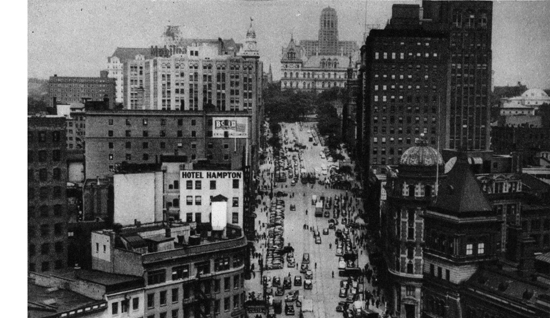
Photograph by Paul Broady

Photograph by courtesy of Union College
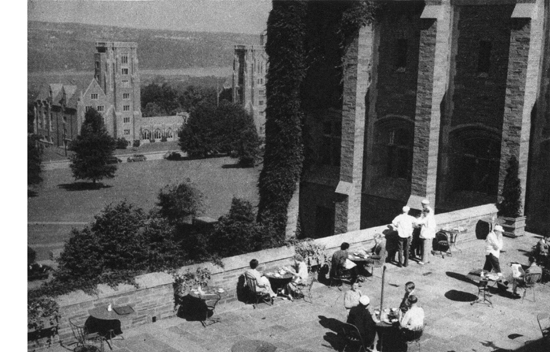
WORLD WAR MEMORIAL FROM WILLARD STRAIGHT TERRACE, CORNELL UNIVERSITY, ITHACA
Photograph by Paul Broady
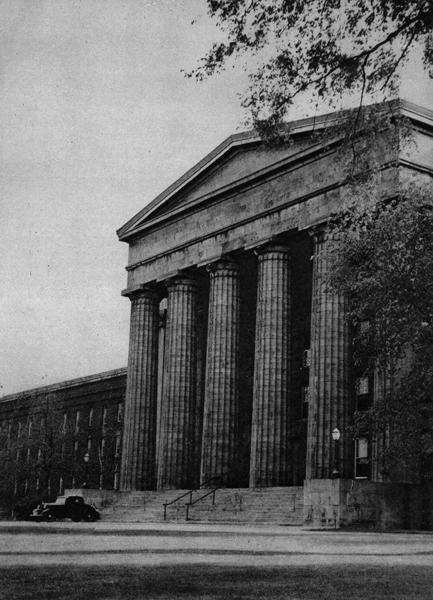
Photograph by T.C. Bannister

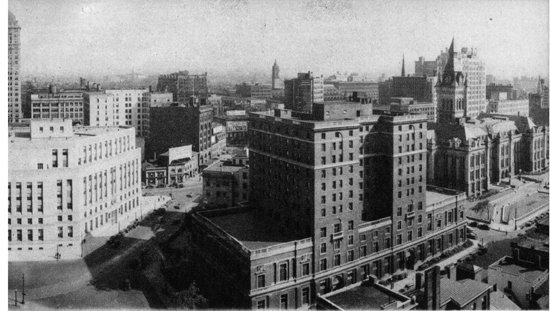
Photograph by Hare
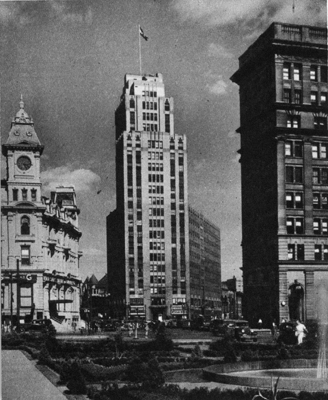
Photograph by courtesy of Syracuse Chamber of Commerce

Photograph by courtesy of Sibley, Lindsay & Curr
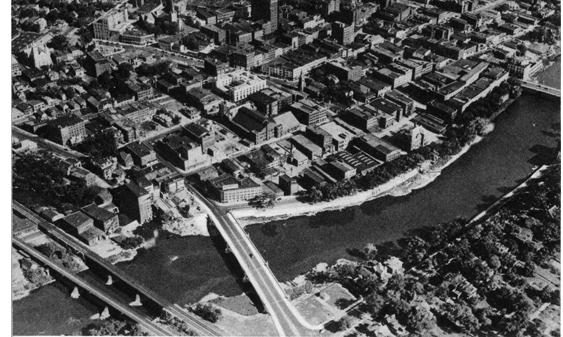
Photograph by Joseph A. Buchta
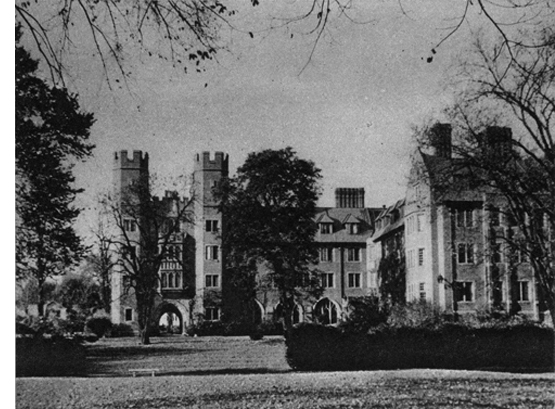
SARA WEY TOMPKINS HALL, ELMIRA COLLEGE, ELMIRA
Photograph by John J. Vrooman

QUEENSBRIDGE HOUSES, NEW YORK CITY
Photograph by courtesy of Fairchild Aerial Surveys, Inc.
Development, housing 3,149 families, built by the U.S. Housing Authority in the slum area of Long Island City. Queensborough Bridge over the East River, straddling Welfare Island. In the background midtown Manhattan; beyond, the Hudson River.


Photograph by John J. Vrooman